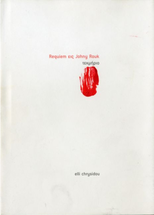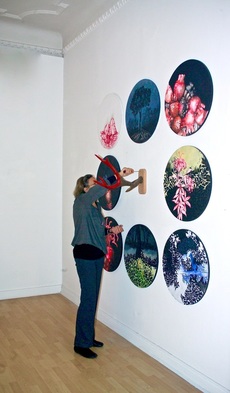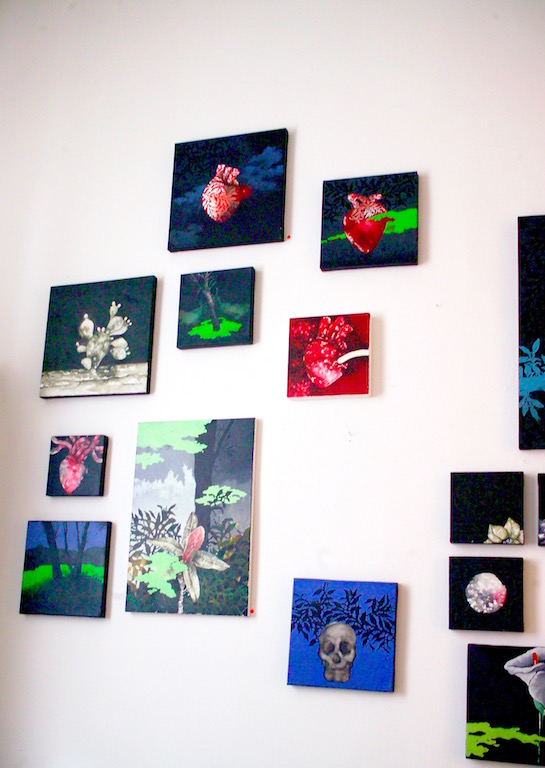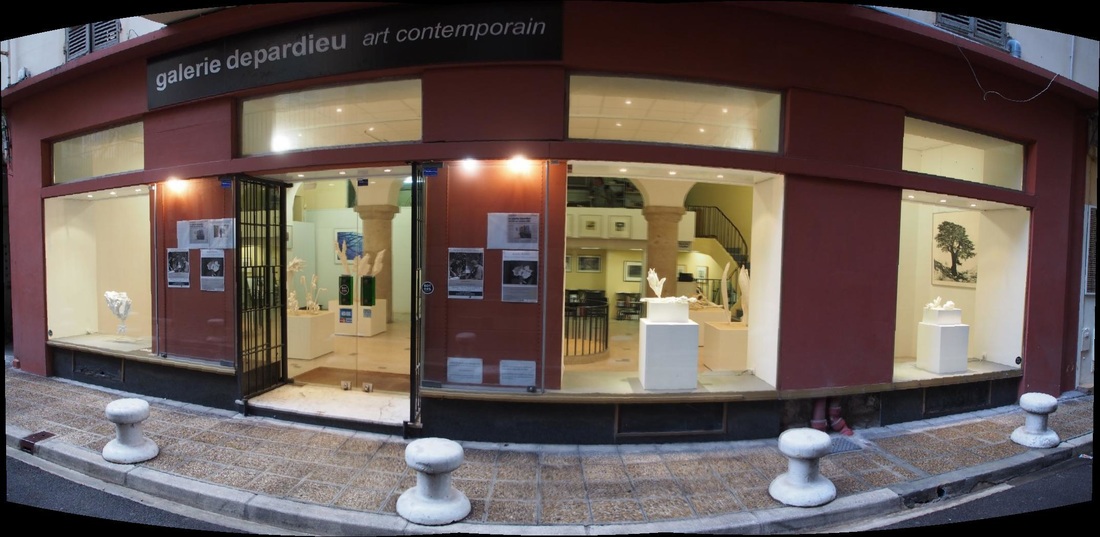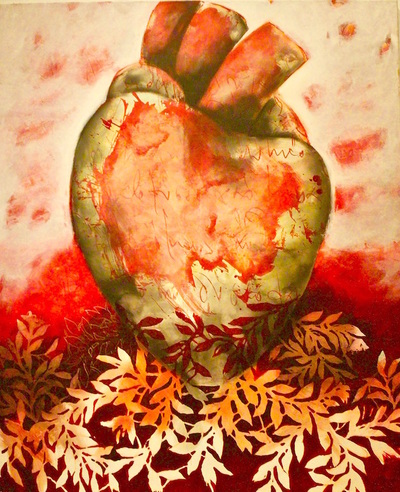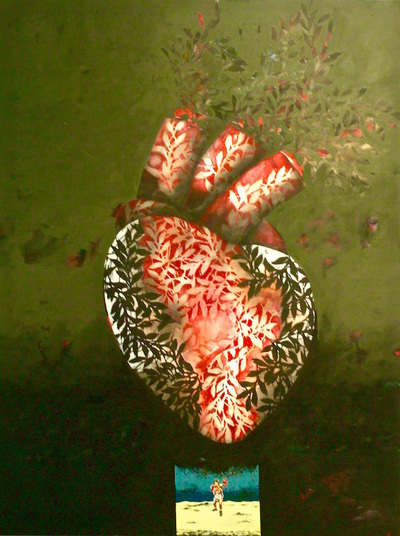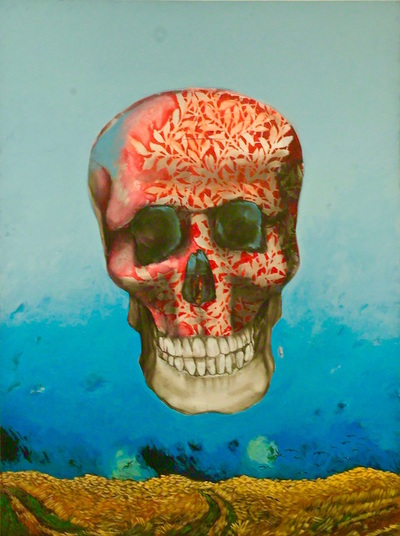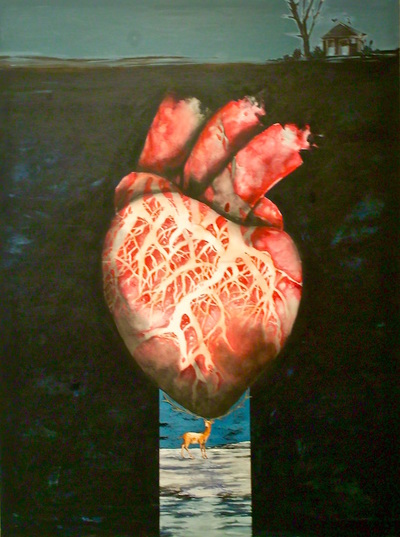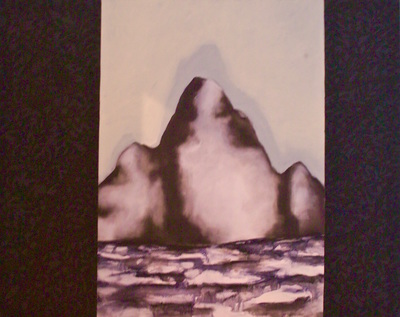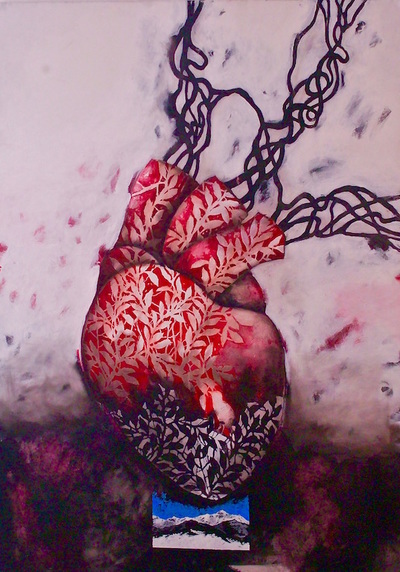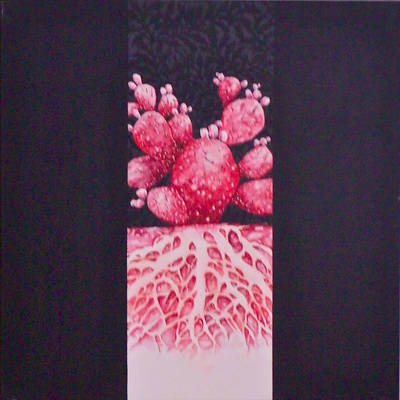The Works
Petites notes à propos du Grand Écorché Vif d'Elli Chrysidou Jacques Bonneval, historien de l'art« Si j'ai accepté la mission d'amitié et de nostalgie que constitue l'écriture d'un texte pour Elli Chrysidou, c'est pour elle et parce que je suis fasciné par le flamboiement macabre de ses œuvres récentes, ce qu'elles ont de baroque jubilatoire, tant elles sont diverses, exubérantes, fluctuantes, inattendues, hypnotiques... En fait, elles ne sont pas seulement baroques. Elles mêlent et éclaboussent de sens tous les genres artistiques jusqu'à l'outrance. Les arts ne sont pas que ressassement mais une constante folle de neurones empanachées de dendrites, d'hémoglobine écarlate et d'ivresse jubilatoire ! Ainsi va l'humanité ! Elli sait depuis longtemps qu'il n'y a peut-être pas d'œuvres d'importance sans outrance, sans blasphème, sans jubilation morbide ! Paradoxe d'une humanité simultanément pensante et empêtrée en ses propres songes dont la folie est toujours l'essentielle prophétie d'un je ne sais quoi ! Le Grand Écorché vif d'Elli Chrysidou n'est-il pas, par essence, la figure de l'outrance ruisselante d'hémoglobine en sa pelisse d'écorché vif ? C'est probable. Mais n'est-ce pas constamment au plus profond du silence tout là-haut sous les voûtes occipitales que s'installe l'ordinaire charivari et les charniers de la démence perpétuelle ? Ce grand Écorché est l'emblématique figure de l'Humanité Éternelle toujours plus stigmatisée par les abondances d'hématidrose (1) qui maculent les suaires. Oui, que serait l'Art avec un A majuscule si nous parvenions à décrypter l'entier de tant de mystères, qu'ils soient de languide nostalgie ou de tant de charades apocryphes ? L'humanité entière serait si profondément ennuyeuse sans la perpétuelle cavale des songes toujours plus échevelés et emberlificotés en leur constante chevauchée ver un là-bas, inaccessible à jamais ! Qu'ils soient baroques, classiques, naïfs ou tout simplement d'exubérante volupté, les artistes tels qu'Élli Chrysidou lacèrent à grand coup d'ongles toujours plus cruels d'indélébiles incunables sur les parchemins de nos cervelles, et gravent sans cesse diastoles/systoles (2), l'histoire d'une fin d'un siècle moribond, empourpré d'hémoglobine et éperdu de lui même. Putain de mort ! Parmi toutes les photographies qu'Elli m'a envoyées, c'est évidemment l'imposante et fascinante figure de son Grand Écorché Vif sous sa pèlerine en lambeaux qui accapare mes yeux écarquillés. Pour seulement se distraire une fois encore avant qu'advienne le pire, dont on dit pourtant qu'il serait la suprême délivrance. Mais de quoi, sinon de nous-même ? Je n'ai d'abord perçu en cette œuvre que rituel macabre ou banale dialectique de la vie et de la mort. Putain de mort qui « tic tac » sans le moindre répit! On dit que c'est parce qu'elle est si ancienne qu'elle ne parle plus que des langues mortes, latin, grec ancien ou yiddish t tant d'idiomes embrouillés au tréfonds de la cervelle. Tout n'est peut-être que radotages, borborygmes, ratures, contre-sens, délires. Je radote au hasard des mots mais rien n'est plus cruel que de songer au supplice de l'Écorché sous cette chasuble de peau. Oui, je pense au bourreau chinois, je pense aussi à Élisabeth Bàthory (3), là-bas, dans sa geôle des Carpates, prisonnière à jamais de son miroir. Y a-t-il plus lacérante cruauté que celle de ce Grand Écorché Vif ? Les fêtes macabres seront à tout jamais infiniment plus captivantes que les distractions qui n'effleurent que d'éphémères illusions. Bien sur, si j'en avais l'aptitude et le temps, je te parlerais encore et encore de ton Grand Écorché. Mais je préférerais de toute évidence que ce soit toi qui m'en révèle les mystères. Le rite de l'écorché vif n'est-il pas la plus cruelle de toutes les damnations ? Éjaculations des pendus de Monfaucon... Et puis tant d'autres ont vénéré la figure de l'Écorché et les mandragores renaissantes au pied du gibet de Monfaucon ruisselant de foutre et de « voie lactée ». Ce qui me fascine dans cette œuvre, c'est qu'elle est aussi plurielle que n'importe quelle existence sur les chemins sans retour. Le Bien et le Mal ne sont-ils pas éternellement d'une même dialectique ? L'existence serait-elle le pire des enfers et la mort à tout jamais sereine ? Saurions-nous seulement que nous existons sans la peur qui nous prouve que nous sommes encore vivants ?
|
<< text only in French
(1) Suintement sanguin
(2) Contraction/expansion du muscle cardiaque (3) dite « la comtesse sanglante », emprisonnée à vie en 1610 en son château de Trencsény, aujourd'hui en Slovaquie et dont Valentine Penrose conta la vie de meurtrière sadique (Gallimard-L'imaginaire). |
Requiem to Johnny Rook
Post-modern society detests anything that exceeds present time boundaries. It simply wants people neither dream nor refer to values or anything else that refers to the future. Yet, people's true nature makes them not only dream and consider their next day but mostly wander in incorporeal time. This vast space, free from any bridges connecting it to the present is, most of the times, the basis of a personal or collective utopia.
Art more than anything else, not the one that simply recycles the pre-made models promoted by the authority centres, always had and always will have time as its main component for its shapes, colours and meaning. As far as contemporary Greek art is concerned, the period between 1985 and 2000 (which is defined intuitively rather than scientifically) seems to be the time period in which the circumstances, reasons and gaps that removed artistic thought and production from the heavy shadow of the -60's generation were formed. It is during this period that a number of artists who approached artistic tradition of the pre-dictatorship and political reform period in a different way appeared, leaning towards the trend that longs for direct and equal intercourse with the present; more specifically with “space-place” and time. These artists embraced an abundance of contrasts and differences and gave in to their influences; as a result they renewed their perception of present tradition. Elements so different and unknown to each other are adjusted to our cultural and social distinctive characteristics which remains stable in all aspects. For instance, distinctive artistic characteristics of northern Europe which were used to unfold the Mediterranean “soul”, still influenced by the post-modernist aesthetics, or even morphologies of images producing post-industrial societies. This phenomenon is applied not only to our country but also to a number of regional artistic centres (to most of them in fact). In Greece, these artists, who are the majority indeed, give us the whole picture for the span mentioned above. Among these artists there are quite a few whose contrasts and differences presented in their works reveal the possibility of resistance, question and uneasiness. Their fighting and restless spirit opposes to meaningless, easy and unprepared, painless elements clearly showing the massive landscape painting of the modern, artistic production which reached our country in the early 21st century. Elli Chrysidou, after a long time in this line of work, eventually freed herself from the ideal mixture of contrasts in her work and aimed to a kind of free painting. Her painting is coming straight from the heart because she acknowledges what the heart is reluctant to say, the limits and responsibilities of her artistic freedom. As far as the symbolic function of either the colours or the dominant patterns on a group of her works is concerned, then I must say that they are both accomplished by the artist to the maximum extend. The heavy colour, the large and often kinaesthetic presentation of images-symbols represent the ability of the mind and the body to escape from the presentation of the world itself. Therefore, the reflection is not its resemblance but its presentation. That is why her paintings have now been released not only from that dry and suffocating realism but also from any attachment either to supernatural or seemingly supernatural. Her paintings are open, warm-hearted and salvific ones. They are adressed to us all urging us to give meaning to what lies beyond our sight, at the land of ultimate questions about the meaning of existence, death, love. This kind of behaviour does not undermine the questions and the answers to the level of folk and fashionable metaphysics but builds the dignity of the human face. It is an ideology. It is also a political point of view. A very distinguishable pattern is that of a heart presented in various ways expressing the incarnation and the fall, destiny, light and darkness. It does not prevent the heart from mixing in time, on the contrary it promotes it to do so. A heart is not eternal; it's a specific order. With predetermined beginning yet unknown ending. The ending is a reality even if the heart is presented either as a frame or painted with flexibility, and plastic actions. Therefore, the heart is time itself. In this exhibition called “Requiem to Johnny Rook”, Chrysidou attempts to surface this sense of time, life and the symbol of the heart through a parallel presentation with a group of images taken from meaningful every day notions. She attempts this by choosing to use a bird, johnny rook. It's the hawk of the Falkland islands, a very clever and wild hawk whose relation with the chimera of time is a revelation that its capabilities are out of time. The rest of the patterns, which include many elements indeed, have a similar effect on us, urging us to perceive limited time as an illusion and motivating us to perceive their morphology and travel through unlimited and infinite time. Additionally, a significant aspect is the momentary sense that urges us to look beyond the horizon where salvation is. Because the charming nature represented by the form of plants can momentarily capture the eye. Yet, the juicy colour of the leaves is ready to give its place to the yellow colour of decline. Similarly, the impressive white, icy mass is ready to turn into water; this element of life is nevertheless neither impressive nor magnificent when used in an artistic form. Chrysidou paints a circle -the constant dialogue between life and death, truth and dishonesty, existence and non-existence, momentary and lasting. With no fake romanticism or modern expressions. Without looking for refuge to the pretentious and fancy notion of post-modern aesthetics but finding herself in a painful process of revealing her personal artistic behaviour. Charis Savopoulos
Art Historian and critic Thessaloniki, August 2008 |
P.S: We can never emphasise enough how significant and catalytic honourableness is in art, no matter how many times we talk about this essential characteristic which is impossible to detach from an artist's artistic potentials. Nevertheless, honourableness without talent, I quote Clement Greenberg, is lacking honourableness, similar to the one of “primitive” painting. Naivety blocks ones eyes from the truth, while the truly honourable artist never has “innocent” heart.
|
